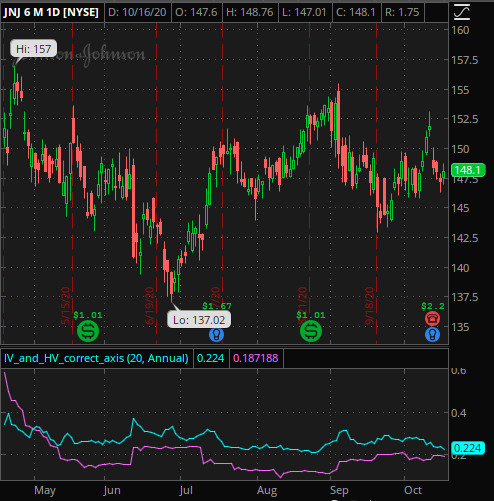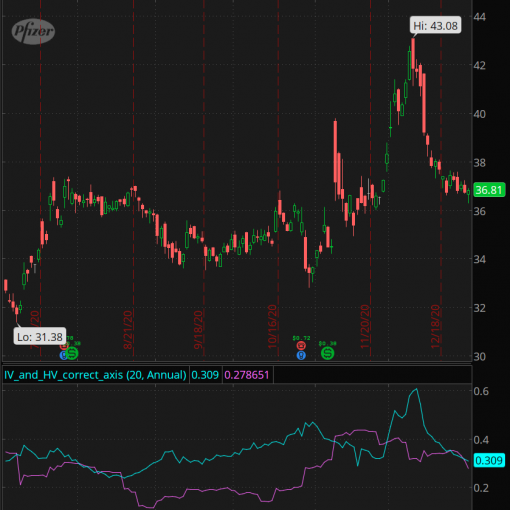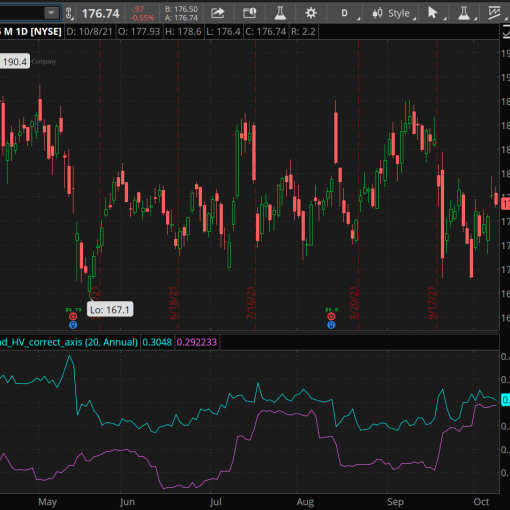10/18/2020 Plan: We return to Johnson and Johnson (Ticker: JNJ) this week for a put spread idea along with a few other put sale ideas as back-up/additional trades

10/18/2020 Plan (continued):
- JNJ- Sell the November 13th 140/135 put spread for 0.61.
- Prices are as of market close 10/16/2020, actual fill and strikes may differ depending on Monday’s open, post will be updated accordingly.
- All trades are for educational purposes and do not constitute advice
10/18/2020 Commentary:
The IV/HV chart in JNJ is pretty interesting – since May, IV has been consistently priced above historical volatility. Note also that we’ve been firmly above 140 since the dip in late June. We place the short strike at 140, outside of the expected move during this timeframe. No earnings in this trade, but the election will occur. A sharp drop off in the market/JNJ will challenge the position, so note that any trades placed expiring after the election have this added risk. .
The return if the spread expires worthless is almost 14% (61/431 = 13.9%).
Additional Ideas:
- Sell DAL Nov 13 24 put for 0.24 or 25 put for 0.31.
- Sell ALL Nov 20 85 put for 1.13. Note – includes earnings and election
- Sell INTC Nov 6 47.5 put for 0.39. Note – includes earnings and election
For each of the put sales, make sure it is cash secured and that you are willing to take ownership of the shares. If not, pass on the trades or spread them to limit the margin/risk.
Reach out with any questions on this or any other trade!
10/19/2020 Entry:
We sell the Nov13 140/135 put spread in JNJ for 0.66. JNJ is down this morning, offering us a bit more premium.
10/26/2020 Update:
The put spread is worth 0.86, for a current paper loss of 0.20. We continue to hold the position this week and will monitor on any sharp drop-offs. JNJ has remained above the 140 level since late June and didn’t go much below 144 this week.
11/1/2020 Update:
The put spread is now worth about 2.40 after the significant downturn in the market last week. We can approach the trade in a few ways. The first is to simply close it, take the loss and move on to the next trade. This is a fine approach and given the win rate of our approach, helps to make sure we remain profitable over the long term. For smaller account sizes, this is (or the last approach) are recommended.
The next approach is to leave the trade on as we have two weeks before expiration and a very significant event in the meantime which should move the market (and JNJ). This is a higher volatility play and to some extent, relies on a smooth election and that a clear winner is named. If that occurs, the volatility in the market should subside and the expectation is the overall market rallies. If that doesn’t occur, the market may drop and the loss may increase.
A third approach is to roll the trade, with the assumption the market will rebound in the future. One can go 2-3 weeks out for a small credit.
A last approach to consider is to sell a call spread, turning the position into a butterfly if the 140/145 call spread is sold or an iron condor if higher strikes are used (142/147, for example). This brings in additional credit to offset the loss – $1.70 for the 140/145 and decreases our total potential loss. The disadvantage is that if JNJ bounces back, we can lose on the trade above 142.36 (0.66 initial credit plus 1.70 additional credit plus the 140 strike price). Our total potential loss would go to 2.64 (5.00 wide strikes minus 2.36 in credits). Personally, I prefer this approach over simply closing the trade as it allows us to still win at an additional cost of only $0.24. We will monitor these different approaches moving forward.
11/8/2020 Update:
After the overall climb in the market this past week, the JNJ spread has recovered and we are now essentially flat on the trade – the spread is worth 0.72. Expiration is this week and we have similar options as last week to adjust.
Rolling the trade is now a bit easier as the put spread is out of the money. As an example, one can roll to next week (expiring Nov 20) and receive a net credit of 0.36 (1.08 credit for the new spread, 0.72 debit for the old). You can even reduce risk and roll to the 139/135 and pull in about 0.06 in credit.
If you want to keep the trade on this week, another way to reduce risk is to tighten the put spread. You can sell the 135 put and buy the 138 put for a 0.26 debit. This brings our total credits down to 0.40, but the most we can now lose is only 1.60. This is a good way to reduce the swings in one’s account given JNJ can easily move $5 this week and is something I’ll look to do tomorrow.
11/15/2020 Close:
With news of a promising vaccine from Pfizer (Ticker: PFE), the market took off on Monday, making this a much easier position to manage. The spread expired worthless at the end of the week, allowing us to take the full $66 profit, for a nice 15% profit in less than a month.
Reach out with any questions on this or any other trade!


